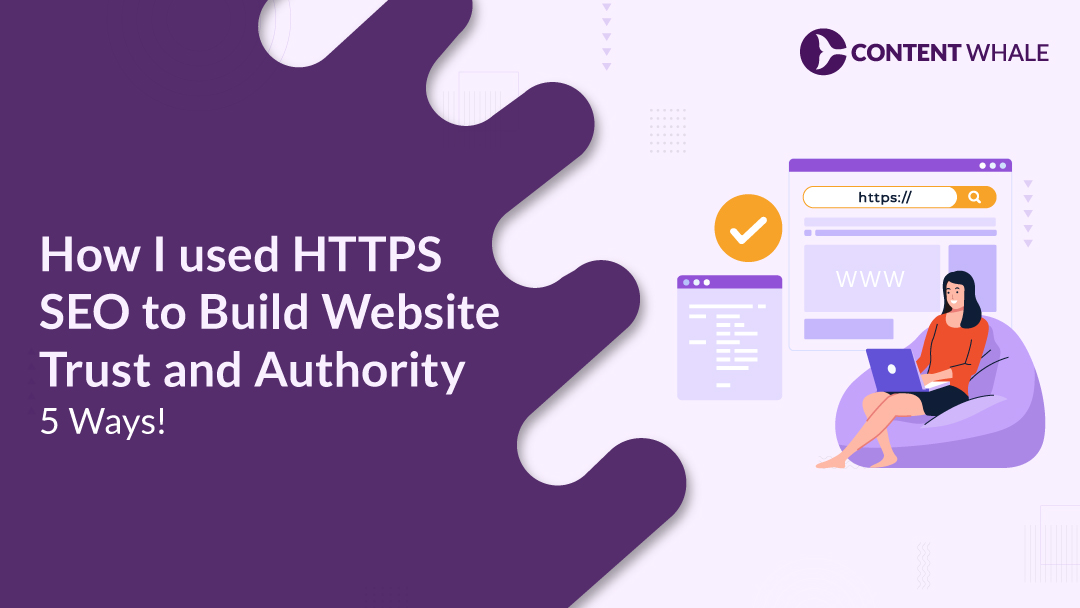The security of your website isn’t just a technical concern—it’s a critical factor for your online success. HTTPS, or Hypertext Transfer Protocol Secure, has become the standard for ensuring that websites are not only safe but also SEO-friendly. But why is this so important?
With cyber threats on the rise, users are becoming more cautious about the websites they visit and interact with. HTTPS not only encrypts data to protect it from potential attacks but also signals to users that your site is trustworthy.
This trust is a key component in improving your website’s search engine rankings. When search engines like Google see that your website is secured with HTTPS, they are more likely to rank it higher in search results, boosting your visibility.
This blog will explore the critical role that HTTPS plays in building user trust and enhancing your website’s SEO performance.
We’ll delve into why HTTPS is essential, how it impacts your search engine rankings, and the steps you can take to implement it effectively.
Let’s start by understanding what HTTPS is and why it has become a non-negotiable standard for websites aiming to establish credibility and authority online.
What is HTTPS and Why is it Important?
HTTPS, which stands for Hypertext Transfer Protocol Secure, is an advanced version of HTTP, the protocol used for transferring data between a user’s browser and a website’s server.
The key difference lies in the “S” at the end of HTTPS, which signifies that all communication between the browser and server is encrypted using SSL (Secure Sockets Layer) or its successor, TLS (Transport Layer Security).
This encryption ensures that sensitive information such as passwords, credit card details, and personal data remain secure from potential eavesdroppers or cybercriminals.
Importance of SSL Certificates
SSL certificates are the backbone of HTTPS, as they facilitate the secure connection between the browser and server.
These certificates are issued by trusted Certificate Authorities (CAs) and are used to authenticate the identity of a website, ensuring users that they are interacting with a legitimate site.
The SSL certificate also provides the encryption key necessary for securing data transmission, which is critical for maintaining the integrity and confidentiality of the information exchanged.
Impact on SEO and Trust
HTTPS plays a pivotal role in SEO and building user trust. From an SEO perspective, Google and other search engines have made HTTPS a ranking factor, meaning that websites secured with HTTPS are more likely to rank higher in search engine results pages (SERPs).
This is because HTTPS not only protects user data but also improves the overall user experience by providing secure browsing. Moreover, HTTPS enhances the accuracy of traffic reports by preserving referral data, which is often lost when using HTTP.
For users, the presence of HTTPS and the accompanying padlock icon in the browser’s address bar signals that their connection is secure and that the website is trustworthy.
This visual indicator is crucial in establishing credibility, especially for e-commerce sites and platforms handling sensitive information.
Websites that continue to operate on HTTP risk being flagged as “not secure” by modern browsers, which can deter visitors and negatively impact both traffic and conversions.
In conclusion, HTTPS is not just about securing data; it is a fundamental aspect of building trust and credibility online, directly influencing your website’s SEO performance and user engagement.
Transitioning to HTTPS is essential for any website aiming to establish authority and maintain user confidence in today’s digital landscape.
1. Enhance User Trust

HTTPS plays a critical role in enhancing user trust by providing a secure browsing experience. When users see the padlock icon next to the URL and the “https://” prefix, they know that the website is secure, which increases their confidence in interacting with it.
This is particularly important for websites that handle sensitive information, such as e-commerce sites or platforms requiring user logins. Here’s how you can leverage HTTPS to build trust:
i) Secure Browsing Experience
HTTPS encrypts the data transmitted between the user’s browser and your website’s server, protecting it from interception by unauthorized parties. This encryption ensures that personal information, passwords, and payment details remain private.
ii) Trust Signals
The visual cues provided by HTTPS, such as the padlock icon and the secure URL, are crucial in building user confidence. These trust signals reassure visitors that their data is safe, which can reduce bounce rates and increase user engagement.
iii) Protection Against Phishing
By ensuring that your website is secured with an SSL certificate, you protect users from phishing attacks. SSL certificates authenticate your website’s identity, preventing users from being redirected to fraudulent sites.
iv) Legal Compliance
Many regulations, such as GDPR and PCI-DSS, require websites to use HTTPS to protect user data. By complying with these regulations, you not only avoid legal penalties but also enhance your website’s credibility.
To maximize the benefits of HTTPS for user trust, ensure that all elements of your website are served securely. This includes updating all internal links, images, and scripts to HTTPS and setting up 301 redirects from HTTP to HTTPS to guide both users and search engines to the secure version of your site.
By implementing these practices, you can create a more secure and trustworthy environment for your users, which is essential for maintaining strong engagement and driving conversions.
2. Boost Search Engine Rankings
Implementing HTTPS not only secures your website but also provides a significant boost to your search engine rankings. Google has been prioritizing secure websites since it introduced HTTPS as a ranking signal in 2014. Although this signal is considered lightweight compared to other factors like content quality, it still plays a crucial role in the overall SEO strategy.
When Google recognizes that a website uses HTTPS, it interprets this as a sign of trustworthiness and credibility. This can lead to better visibility in search engine results pages (SERPs), as secure sites are preferred over non-secure ones. Additionally, HTTPS helps in reducing bounce rates, as users are more likely to stay on a site they perceive as secure, which in turn positively impacts SEO performance.
Here are some actionable tips to boost your SEO with HTTPS:
i) Obtain a Valid SSL Certificate
Ensure you have an SSL certificate from a trusted Certificate Authority (CA). Options include Domain Validation (DV) for basic security, Organization Validation (OV) for higher trust, and Extended Validation (EV) for the highest level of trust and security. Choose the one that best suits your business needs.
ii) Implement 301 Redirects
Redirect all traffic from HTTP to HTTPS using 301 redirects. This step is vital to ensure that both users and search engines are directed to the secure version of your website, thereby preserving your SEO rankings.
iii) Update Internal Links
Ensure all internal links on your site point to the HTTPS version of your pages. This prevents mixed content issues and ensures that all elements of your site are served securely.
iv) Enable HTTP Strict Transport Security (HSTS)
HSTS ensures that browsers only connect to your site over HTTPS, providing an additional layer of security and improving user trust.
v) Monitor and Optimize Site Speed
While HTTPS can introduce a slight overhead, modern protocols like HTTP/2 can mitigate this, ensuring your site remains fast and responsive. This is important because site speed is another factor that affects your search rankings.
By following these best practices, you can enhance your site’s security and take advantage of the SEO benefits that come with using HTTPS, ultimately leading to improved search rankings and increased organic traffic.
3. Prevent Data Breaches

Preventing data breaches is a critical aspect of maintaining a secure website, and HTTPS plays a crucial role in this process. By encrypting the data transmitted between the user’s browser and your website’s server, HTTPS protects sensitive information from being intercepted by cybercriminals. This encryption ensures that even if the data is intercepted, it cannot be easily read or used maliciously.
Here are some key strategies to safeguard user data and prevent data breaches:
i) Implement SSL/TLS Encryption
By securing your website with an SSL certificate, you create a secure channel for data transmission. This not only prevents data breaches but also protects against phishing attacks by ensuring users are connected to the legitimate website.
ii) Use Strong Access Controls
Implementing multi-factor authentication (MFA) and role-based access controls (RBAC) ensures that only authorized personnel have access to sensitive data. Regular audits of user access can help identify and revoke unnecessary permissions, reducing the risk of unauthorized access.
iii) Regularly Update and Patch Systems
Keeping your software up to date is crucial to preventing data breaches. Cybercriminals often exploit vulnerabilities in outdated software, so it’s essential to regularly apply security patches and updates to all systems and applications.
iv) Encrypt Data at Rest and in Transit
In addition to using HTTPS for data in transit, ensure that sensitive information stored on your servers is also encrypted. This adds an additional layer of security, making it difficult for attackers to use the data even if they manage to gain access.
v) Conduct Regular Security Assessments
Regular vulnerability scans and penetration tests help identify potential weaknesses in your security defenses. Addressing these vulnerabilities promptly can prevent them from being exploited by cybercriminals.
vi) Educate Employees on Cybersecurity
Often, human error is a contributing factor in data breaches. Regular training on phishing, strong password practices, and recognizing potential threats can empower your team to act as the first line of defense against cyber threats.
By following these practices, you can significantly reduce the risk of data breaches, protect your users’ sensitive information, and maintain a secure and trustworthy website.
Implementing these measures not only safeguards your website but also aligns with best practices for SEO, as search engines favor secure sites in their rankings.
4. Improve Conversion Rates
HTTPS not only enhances security but also plays a significant role in boosting conversion rates, especially for e-commerce websites. Shoppers are more likely to complete their purchases when they feel their personal and payment information is protected. Here are some effective strategies to leverage HTTPS and SSL to improve your conversion rates:
i) Build Trust with Security Badges
Displaying security badges such as SSL certificates prominently on your website can reassure customers that their data is secure. This trust is critical in reducing cart abandonment and increasing conversions, as customers are more likely to complete purchases when they feel safe.
ii) Simplify the Checkout Process
A streamlined and user-friendly checkout process is crucial in minimizing cart abandonment. Offering options like guest checkout, minimizing the number of form fields, and enabling auto-fill can significantly reduce friction during the purchase process, leading to higher conversion rates.
iii) Optimize Website Performance
Fast loading times and a seamless browsing experience are essential for retaining customers and encouraging them to complete their transactions. Regularly monitor your site’s performance, optimize for mobile responsiveness, and ensure that there are no technical glitches that could disrupt the checkout process.
iv) Provide Clear Return Policies and Shipping Information
Transparency about shipping costs and return policies can greatly reduce hesitation among shoppers. Offering free shipping or clear, upfront information about costs and return options helps build trust and can encourage shoppers to finalize their purchases.
v) Offer Flexible Payment Options
Providing a variety of payment methods, including digital wallets and installment plans, can cater to different customer preferences and make it easier for them to complete their purchases. This flexibility is especially important for higher-priced items, where payment plans can reduce the perceived financial burden.
Implementing these strategies can effectively reduce cart abandonment and improve your e-commerce conversion rates, taking advantage of HTTPS’s secure environment.
5. Provide a Seamless User Experience

Implementing HTTPS on your website enhances security and significantly improves user experience and site performance. When a site is secured with HTTPS, it can utilize the HTTP/2 protocol, which offers several performance enhancements over the older HTTP/1.1.
These enhancements include multiplexing, which allows multiple data requests to be processed simultaneously, server push, which sends resources to the browser before they are requested, and header compression, which reduces the size of data transferred. Together, these features contribute to faster page load times, resulting in a smoother user experience.
In addition to these technical benefits, HTTPS contributes to a better user experience by providing visible security cues, such as the padlock icon in the browser’s address bar, which reassures users that their data is protected. This is crucial for building trust and encouraging users to interact with your website without hesitation.
To further optimize your website’s speed and user experience, consider implementing the following tips:
i) Enable Browser Caching
This allows frequently accessed resources to be stored locally on the user’s device, reducing the time it takes to load pages on subsequent visits.
ii) Optimize Images and Minify Code
Compressing images and minifying CSS and JavaScript files can significantly reduce the size of your web pages, leading to faster load times.
iii) Use a Content Delivery Network (CDN)
A CDN stores copies of your website’s files on multiple servers around the world, allowing users to load pages from the server closest to them, which improves loading speed.
By focusing on these strategies, you can enhance both your site’s speed and overall user experience, making your website not only secure but also efficient and user-friendly, which are key factors in improving your site’s SEO and retaining visitors.
Conclusion

Switching to HTTPS is more than just a technical upgrade—it’s a strategic move that can significantly enhance your website’s trustworthiness, SEO performance, and overall business outcomes.
By implementing HTTPS, you not only protect user data with robust encryption but also align with Google’s SEO preferences, which favour secure sites in search rankings. This shift can lead to increased organic traffic, lower bounce rates, and higher user engagement.
The benefits of HTTPS extend beyond security and SEO. It builds a foundation of trust, encouraging users to stay longer on your site, complete transactions, and return in the future.
These factors contribute to a seamless user experience, which is crucial for boosting conversion rates and achieving business success.
To fully capitalize on the advantages of HTTPS, it’s essential to implement it correctly—this includes securing an SSL certificate, updating all internal links, and setting up proper redirects.
Regular monitoring and maintenance are also key to ensuring your site remains secure and performs optimally.
If you’re looking to enhance your online presence and build a secure, credible website, consider partnering with Content Whale.
We specialize in creating SEO-optimized, engaging content that aligns with best practices for security and user experience.
Let us help you navigate the complexities of HTTPS and SEO to elevate your website’s authority and performance.
FAQs
What is HTTPS, and how does it work in SEO?
HTTPS, or Hypertext Transfer Protocol Secure, encrypts data exchanged between a user’s browser and a website’s server, ensuring secure communication. From an SEO perspective, HTTPS is crucial because Google prioritizes secure websites in its rankings, giving them a competitive edge.
Implementing HTTPS not only protects user data but also signals to search engines that your site is trustworthy, which can improve search engine rankings.
How does HTTPS build user trust on a website?
HTTPS builds user trust by providing a secure browsing experience. Users are more likely to interact with and share sensitive information on websites that display security indicators such as the padlock icon and “https” in the URL.
This visible assurance fosters confidence in the site’s security, reducing bounce rates and encouraging more engagement and transactions.
What are the benefits of SSL certificates for website security?
SSL certificates are essential for establishing a secure connection between the user’s browser and the website. They ensure that all data transmitted remains encrypted and protected from potential threats.
Beyond security, SSL certificates also contribute to better SEO rankings and increased user trust, making them a crucial component of any website’s security strategy.
How can I transition my website from HTTP to HTTPS?
Transitioning from HTTP to HTTPS involves obtaining an SSL certificate, installing it on your server, and updating all internal links to reflect the new HTTPS URLs.
It is also important to set up 301 redirects from the old HTTP pages to the new HTTPS pages to preserve SEO rankings and ensure users are directed to the secure version of your site.
Regular monitoring for mixed content issues and updating Google Search Console are also necessary steps in this process.
What are the key SEO advantages of using HTTPS?
The key SEO advantages of using HTTPS include improved search engine rankings, as Google favors secure websites.
HTTPS also helps in preserving referral data in analytics, provides a better user experience with faster loading times when combined with HTTP/2, and enhances overall user trust.
These factors collectively contribute to higher engagement and lower bounce rates, which are critical for SEO success.





